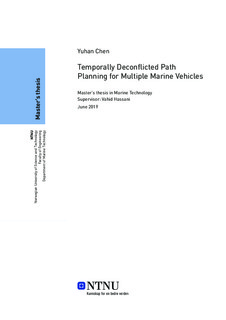| dc.description.abstract | Over the past few years, growing interests and demands have been witnessed in the development of Automatic Surface Vehicle(ASV) operation, especially in controlling fleet of vehicles to perform complex missions. Basing on the path planning algorithm which generates single path between two points, guiding multiple vehicles to their own ends while avoiding possible inter-vehicle collisions brings more challenges and thus requires more versatility. These kind of algorithms need to first consider goal related influencing factors like environmental constraints and vehicle dynamics. In multiple vessels scenario there would also be some specific requirements like path deconfliction in time or space, final arrival synchronizing or avoiding inter-vehicle communication constraints. Further, measurements and optimized solutions will also be needed, such as energy and length minimized path.
The multiple path planning algorithm is developed basing on single path generation optimization algorithm using Bézier curves. For arbitrary number of vehicles, path planning algorithm capable of leading each vehicle to its assigned target is proposed. For vehicle motion at the intersection points, temporal deconfliction is an important issue to be taken care of. To avoid inter-vehicle collisions, first the motion along the whole path and its corresponding speed need to be defined. After assigning the speed, time profile of each point could be obtained, as well as the distance between two vehicles at a certain time instant.
Further, for the crossing point which would be shown geometrically on the path, temporal deconfliction are formulated as constraints in the framework of optimization problem, as well as vehicle dynamic like velocity and acceleration restrictions, in order to satisfy the physical limitations and avoid problems in path following. Cost function is chosen to penalize the exceeding operation time, thus a feasible solution with shortest time and smooth speeding process could be obtained. And despite of the different length of path, they would finally arrive simultaneously.
Finally, a series of simulation results are presented in the last chapter, showing the feasibility and efficiency of the algorithm in multiple path planning. By presenting simulation scenarios with different conditions like path number, random obstacles and velocity limitations, the versatility of the proposed algorithm could be shown as well. By this end, the conclusion could be made that paths for arbitrary number of vessels are temporally deconflicted with simultaneous arriving time. Some challenges so far still existing would be revealed through discussion, and indicate some crucial points for the future work. | |
